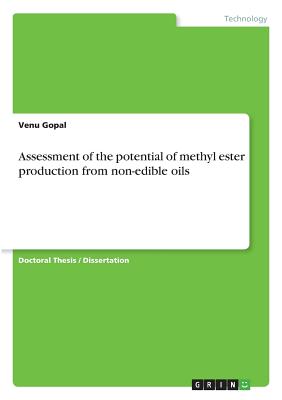
Assessment of the potential of methyl ester production from non-edible oils
Paperback
ISBN13: 9783668795761
Publisher: Grin Verlag
Published: Oct 8 2018
Pages: 244
Weight: 0.71
Height: 0.55 Width: 5.83 Depth: 8.27
Language: English
Also in
General Nature
Trees and Shrubs of Minnesota: The Complete Guide to Species Identification
Smith, Welby R.
Hardcover
Mushrooms of the Upper Midwest: A Simple Guide to Common Mushrooms
Yerich, Kathy
Marrone, Teresa
Paperback
Plants of the Pacific Northwest Coast: Washington, Oregon, British Columbia and Alaska
Pojar, Jim
MacKinnon, Andy
Paperback
Peterson Field Guide to Birds of Eastern & Central North America, Seventh Ed.
Peterson, Roger Tory
Paperback
Peterson Field Guide to Medicinal Plants & Herbs of Eastern & Central N. America: Third Edition
Foster, Steven
Duke, James A.
Paperback
The Forager's Harvest: A Guide to Identifying, Harvesting, and Preparing Edible Wild Plants
Thayer, Samuel
Paperback
How to Read the Wilderness: An Illustrated Guide to the Natural Wonders of North America
Nature Study Guild
Hardcover
The Backyard Birdsong Guide Eastern and Central North America: A Guide to Listening
Kroodsma, Donald
Hardcover
Peterson Field Guide to Mushrooms of North America, Second Edition
McKnight Ward, Kirsten
McKnight, Karl B.
Rohrer, Joseph R.
Paperback
Digging Into Nature: Outdoor Adventures for Happier and Healthier Kids
Swanson Glassy MD, Danette
Sarin Tandon MD Mph, Pooja
Paperback
Basic Butchering of Livestock & Game: Beef, Veal, Pork, Lamb, Poultry, Rabbit, Venison
Mettler, John J.
Paperback
A Peterson Field Guide to the Birds of Eastern and Central North America: Large Format Edition (Large Print Edition)
Peterson, Roger Tory
Paperback
Mushrooms of the Northeast: A Simple Guide to Common Mushrooms
Sturgeon, Walt
Marrone, Teresa
Paperback
National Geographic Guide to National Parks of the United States 9th Edition
National Geographic
Paperback
Drawing Nature: The Creative Process of an Artist, Illustrator, and Naturalist
Feltner, Linda Miller
Hardcover
Mushrooms of the Redwood Coast: A Comprehensive Guide to the Fungi of Coastal Northern California
Schwarz, Christian
Siegel, Noah
Paperback
Foraging Guide: Identifying and Locating Regional Edible Wild Plants and Mushrooms
Greeny, Mona
Paperback
The Little Book of Mushrooms: An Illustrated Guide to the Extraordinary Power of Mushrooms
Dorr, Alex
Hardcover
The Backyard Birdwatcher's Bible: Birds, Behaviors, Habitats, Identification, Art & Other Home Crafts
Sterry, Paul
Perrins, Christopher
Ellis, Sonya Patel
Hardcover
The Bay Area Forager: Your Guide to Edible Wild Plants of the San Francisco Bay Area
Feinstein, Kevin
Andler, Mia
Paperback
Northeast Ferns: A Field Guide to the Ferns and Fern Relatives of the Northeastern United States
Chadde, Steve W.
Paperback
Habitats of North America: A Field Guide for Birders, Naturalists, and Ecologists
Campbell, Iain
Chaon, Phil
Paperback
Peterson Field Guide to Reptiles and Amphibians Eastern & Central North America
Conant, Roger
Powell, Robert
Collins, Joseph T.
Paperback
Mushrooming: An Illustrated Guide to the Fantastic, Delicious, Deadly, and Strange World of Fungi
Borsato, Diane
Hardcover
Nature's Garden: A Guide to Identifying, Harvesting, and Preparing Edible Wild Plants
Thayer, Samuel
Paperback
Edible Wild Plants: A North American Field Guide to Over 200 Natural Foods
Elias, Thomas
Dykeman, Peter
Paperback
The Shorebirds of North America: A Natural History and Photographic Celebration
Dunne, Pete
Karlson, Kevin T.
Hardcover
Southeast Foraging: 120 Wild and Flavorful Edibles from Angelica to Wild Plums
Bennett, Chris
Paperback
Animal Tracks: A Folding Pocket Guide to the Tracks & Signs of Familiar North American Species
Kavanagh, James
Other
Northeast Foraging: 120 Wild and Flavorful Edibles from Beach Plums to Wineberries
Meredith, Leda
Paperback
The Trails of M-22: 48 of the Most Beautiful Paths Along Michigan's Most Beautiful Highway
DuFresne, Jim
Paperback
North American Bird Watching for Beginners: Field Notes on 150 Species to Start Your Birding Adventures
Stiteler, Sharon
Paperback
Edible and Medicinal Flora of the West Coast: The Pacific Northwest and British Columbia
Varner, Collin
Paperback
Wild Rescues: A Paramedic's Extreme Adventures in Yosemite, Yellowstone, and Grand Teton
Grange, Kevin
Paperback
Rocks & Minerals of Washington and Oregon: A Field Guide to the Evergreen and Beaver States
Lynch, Dan R.
Lynch, Bob
Paperback
The Julia Rothman Collection: Farm Anatomy, Nature Anatomy, and Food Anatomy
Rothman, Julia
Paperback
50 Hikes with Kids Virginia and Maryland: With Delaware, West Virginia, and Washington DC
Gorton, Wendy
Humphreys, Alison
Paperback
Foxfire 5: Ironmaking, Blacksmithing, Flintlock Rifles, Bear Hunting
Foxfire Fund, Inc
Wigginton, Eliot
Paperback
Foxfire 4: Fiddle Making, Spring Houses, Horse Trading, Sassafras Tea, Berry Buckets, Gardening
Foxfire Fund, Inc
Paperback
Seashells of Georgia and the Carolinas: A Beachcomber's Guide
Witherington, Dawn
Witherington, Blair
Paperback
Foxfire 3: Animal Care, Banjos and Dulimers, Hide Tanning, Summer and Fall Wild Plant Foods, Butter Churns, Ginseng
Foxfire Fund Inc
Paperback
The Bees in Your Backyard: A Guide to North America's Bees
Wilson, Joseph S.
Carril, Olivia Messinger
Paperback
Wildflowers of the Pacific Northwest: Your Way to Easily Identify Wildflowers
Miller, George Oxford
Paperback
Rocks & Minerals of the Pacific Coast: Your Way to Easily Identify Rocks & Minerals
Lynch, Dan R.
Lynch, Bob
Paperback
The Complete Birds of the World: Every Species Illustrated
Arlott, Norman
Van Perlo, Ber
Mata, Jorge R. Rodriguez
Hardcover


 Sign-In
Sign-In Cart
Cart